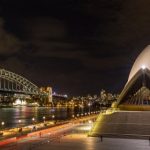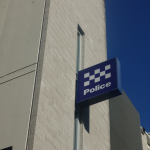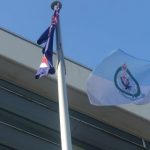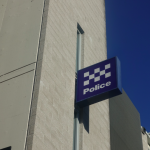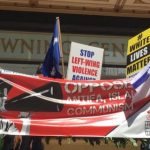Are the Boys in Blue Really There to Protect You?
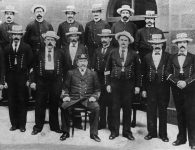
There’s a popular perception in mainstream society that the institution of the police was created to protect and serve the interests of the general population, and that officers on the beat are there to prevent crime and promote the interests of justice.
Indeed, many believe that police have always been a part of the community, and cannot imagine a society where you could not pick up the phone and make a call to the boys in blue.
To combat the mobilising poor
But the fact is that prior to the nineteenth century, the institution of the police was not around as we know it today. Author David Whitehouse explains that the police service, in its modern form, was first created in the US and UK between 1825 and 1855.
What’s more, the institution’s goal was not to stop crime and it did not develop any new methods for preventing it. Rather, the ruling elites established police forces to combat the collective actions that were threatening their interests: mainly to guard against mobilising workers.
“So the police are a response to crowds,” writes Whitehouse, “not to crime.” The major threats to the interests of the upper class at the time were striking workers in England, rioting crowds in the north of the US and the threat of slave insurrections in the south of the States.
It was at that time that the modern wage-labour capitalist society was emerging and the owners of the means of production had to protect their interests from the forces that were simultaneously fostering the growth of this system, while at the same time gaining little benefits from it.
The police weren’t needed
Whitehouse elaborates that before the great wealth disparity that exists in the world today, communities were more reliant on themselves to enforce social norms.
When capitalist society was emerging, people who lived in towns kept an eye out for others who were transgressing the collective social norms and, if someone did so, they would share the information and the perpetrators were dealt with.
Back in those times, apart from the aristocratic rulers, the majority of people living in the townships had greater social equality, so evidently, there was less incentive to rip someone else off, or pilfer another person’s property as the wealth that did exist was more evenly distributed.
The British experience
In early nineteenth century Britain, as the shared lands – or commons as they were referred to then – became enclosed, the peasants were pushed off the land and moved into the growing cities to become the workers in the newly industrialising centres.
After some years, they began organising and the ruling classes started sending in the army to subdue groups of protesting and striking labour that, at times, could number in the tens of thousands.
This led to the establishment of the London police force in 1829. The institution was tasked with “inflict[ing] nonlethal violence” upon the crowds,” and thereby break these groups up without creating martyrs.
And over in Trumpsville
New York in the early 1800s had a volunteer organisation called ‘the watch’. These people would patrol the streets at night to make sure nothing untoward was happening. This was around the same time that workers began organising.
During the first three decades of the century, black workers rioted four times to ensure that former slaves weren’t sent back to their previous masters and a life of servitude.
But it was the 1828 New Year’s Eve riot which comprised 4,000 Anglo-American workers that really gave the wealthy families of New York a fright. By 1845, what used to be known as the watch formally became the New York City Police Department.
The institution grew into a large and professionalised police force, with a military chain of command.
The Deep South
Not surprisingly, in the old apartheid southern states of the US things were a tad harsher. Whitehouse points out that even before the New York police became organised, down in Charleston, South Carolina, one of the world’s first modern police forces was formed.
It was initially made up of what were known as the ‘slave patrols’, which were armed white men that walked the streets at night looking for any dark-skinned troublesome characters.
Around this time, the institution of slavery started to be abolished in the urban areas and the white population began to worry about how to deal with the development.
As the racial divisions and slavery laws began to change, the state decided it needed to enforce the dominance of the old slave masters. This led to the formation of the City Guard, which was comprised of slave patrol members. But over time, the white citizens became increasingly vulnerable.
The guard then developed into a 24 hour police service, run along even more militarised lines than its New York counterparts.
Black lives matter
As we all know, this is all history and, nowadays, society has become much more enlightened. That’s unless one takes a look at movements such as the #BlackLivesMatter campaign in the States.
This activist movement aims to raise awareness and prevent the continuation of circumstances that allow the systemic killing of African-Americans at the hands of US police, who for the most part are not prosecuted for the lives they’ve taken.
The failure to prosecute police, but rather to allow them to police themselves, is perhaps not surprising given the institution was not established to serve, or be made accountable to, the general populace.
Incarcerated Indigenous Australia
And let’s not forget what happened on the sovereign soils of the First Nations peoples in Australia. From the moment the British occupied Australia, they began destroying the cultures and societies of the Aboriginal and Torres Strait Islander peoples via the Frontier Wars.
And what about the focus of policing today? When it comes to the adult prison population in Australia, Aboriginal and Torres Strait Islander people are heavily overrepresented. As of December last year, Indigenous people comprised 10,788 of the 39,568 incarcerated people in Australian correctional facilities.
While Australia’s First Peoples only make up about 2 percent of the nation’s population, they represent 27 percent of the population behind bars, they’re fourteen times more likely to be in custody than the country’s non-Indigenous people.
There is an enormous amount of research to suggest that police are more likely to confront, arrest and prosecute Indigenous people, and those of lower socioeconomic status, than the upper echelons of society.
New South Wales police
The NSW police force is one of the largest police organisations in the English speaking world and, as the Wood Royal Commission pointed out 20 years ago, one of the most historically corrupt.
It began as the first civilian police force in Australia in 1789 to guard the town of Sydney. Back then, it was known as the ‘Night Watch’, which sounds a lot like those other organisations being formed around the western world at the time.
In 1862, all the watch teams were combined under the Police Regulation Act 1862 to form the NSW Police Force.
In June 1987, the NSW police force and the NSW police department amalgamated. Today, the force comprises 19,516 employees, with over fifteen and a half thousand officers and close to 4,000 civilian staff. It now operates under the Police Act 1990 and the Police Regulations 2008.
So if you are approached by a police officer, just be wary and remind yourself that they’re not necessarily there to help you or prevent crime – they’re there to protect the interest of the state.



